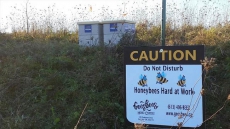TORONTO - Connie Glen isn't sure what she did exactly, but in February she started getting unexplained pain in her left heel — and seven months, several practitioners and about $2,000 later, it's still not entirely healed, though she's finally seeing some improvement.
Glen has plantar fasciitis, a common foot injury that can make walking even short distances an ouch-inducing exercise and one that has derailed many a planned marathon among running enthusiasts.
The condition occurs when the plantar fascia — a thick band of tissue that runs along the bottom of the foot from the heel bone to the toes — becomes inflamed, typically causing stabbing heel pain that for some people can be nothing short of excruciating.
This band of tissue supports the arch of the foot; putting too much tension on the fascia through exercise, improper footwear or being overweight can cause micro-tears that lead to inflammation and pain.
Glen, whose exercise routine had ironically included yoga and pilates to help stretch and strengthen her muscles to prevent injury, had started taking twice-weekly barre classes that incorporate some of the "up-on-your-toes" exercises ballet dancers use to limber up.
"And I started getting this funny pain in my heel once in a while, but I didn't relate it to the barre class," says the 49-year-old from Oakville, Ont., who works as a quality manager for a major food company.
"The mornings were just excruciating until I'd taken the first five or six steps," Glen says of getting out of bed. "But it wasn't just the mornings. It was every time I got up from my desk."
Vancouver podiatrist Joseph Stern says that's a classic sign of plantar fasciitis, experiencing heel and often arch pain when walking after non-weight-bearing rest — whether that's taking one's first steps in the morning, getting up after watching a movie or following stretches sitting on the couch or at a desk.
"Some people will say it hurts for the first bunch of steps, then it calms a bit and then as the day progresses, it hurts," says Stern, president of the Canadian Podiatric Medical Association.
About 90 per cent of cases have biomechanical underpinnings, in which the foot does not have a sound foundation when a person is standing, walking or running, he says, pointing to such common causes as wearing worn-out or unsupportive shoes, carrying excess pounds or having tight calf muscles.
"Treatment is like making a cake, as I tell patients. It's going to be a little bit of this, a little bit of that. And sometimes one thing works and thank you very much."
Initial treatment usually involves having a patient roll the arch of their sole over a cold water bottle or tennis ball several times a day to stretch out the fascia.
"Stretches are good, like pulling your toes up towards your nose, holding it for 20 to 40 seconds, then do it again," says Stern. "Do that before you get out of bed, do that three or four more times a day."
If the pain persists, practitioners may tape the heel and sole to correct over-pronation, where the foot and ankle rolls inward too much.
"And that kind of gives a good support to the foot, so its simulating an orthotic," he says. "It's putting the foot in a better alignment, a more 'neutral' position or supporting the foot from the heel up to the forefoot."
Orthotics — inserts for shoes that support the arch — can also help eliminate plantar fasciitis, but Stern recommends those created from a 3-D cast of the patient's foot rather than orthotics based on two-dimensional foot impressions read by a computerized mat that are typically sold in drug stores.
Other treatments include physiotherapy, acupuncture or a shot of cortisone in the affected part of the foot to calm the inflammation. Some practitioners recommend a night splint, a brace that holds the foot with the toes pointing up to gently stretch the fascia while a person sleeps.
Dr. Chris Woollam, a Toronto sports medicine specialist, says plantar fasciitis is a common complaint among patients, especially runners.
"I always say that if you haven't had that, and you've got a high arch, then you haven't been doing much," says Woollam, who's had a number of bouts himself in both feet.
"I usually have sort of a graded approach so that at the very beginning when somebody comes in and they've had it a few weeks, I usually say you have to stretch out the plantar ligament or do some calf stretch-type work."
He also recommends rolling the arch over a frozen water bottle for about five to seven minutes: the cold can ease the inflammation while the shape of the bottle helps stretch out the fascia.
"Some people, I'll say about 30 per cent of people, do OK with just that. Now they know what it is, they're happy and away they go."
But Woollam concedes that plantar fasciitis can be stubbornly difficult to overcome in some patients.
After trying a number of treatments — including a deep massage called active release therapy, or ART — and failing to rid a patient of the chronic foot pain, "we have to pull out the big guns," he says.
Some practitioners use laser ultrasound, but Woollam prefers shock-wave therapy, which he's had to treat his own plantar fasciitis "and it got way better."
"What that does is it really hammers into the area, so it's actually quite painful. The concept is it takes a scarred area and creates a new injury that then heals," says Woollam, estimating that shock-wave therapy works in about 80 per cent of patients.
Surgical repair is rarely performed and considered a last resort when all other treatments have failed, he says.
For Connie Glen, who saw a chiropractor, physiotherapist and osteopath (who determined she had a seven-millimetre tear in her fascia) before being referred to Woollam, it was shock-wave therapy that she says finally started her stepping in the right direction.
"What's frustrating for me is it's not like I ignored it. I was on this within the first week of getting it and it just kept progressing."
That's why Stern advises that anyone with heel/sole pain shouldn't put off seeking treatment.
"With most of my patients, it's months and months until they come in," he says. "Jump on it, don't let it linger ... because if you let it linger, it's just harder and harder to get rid of."





